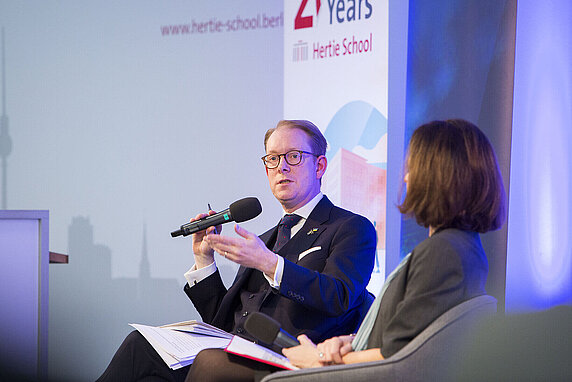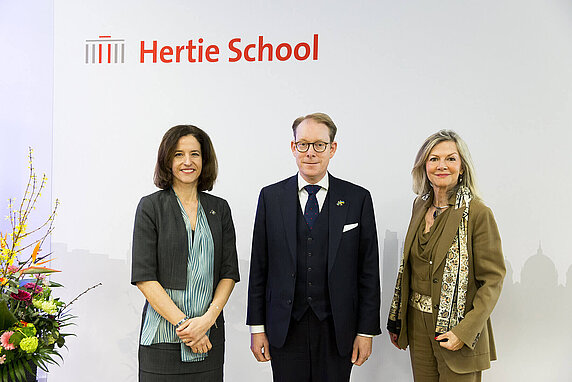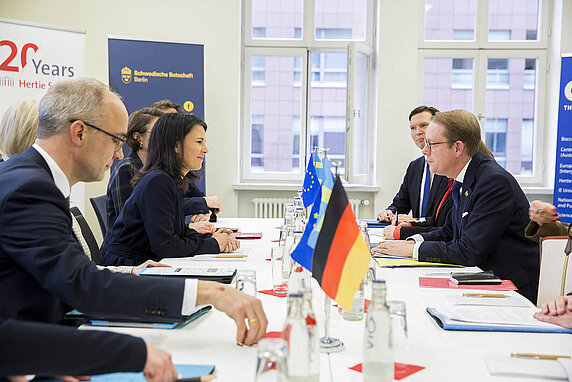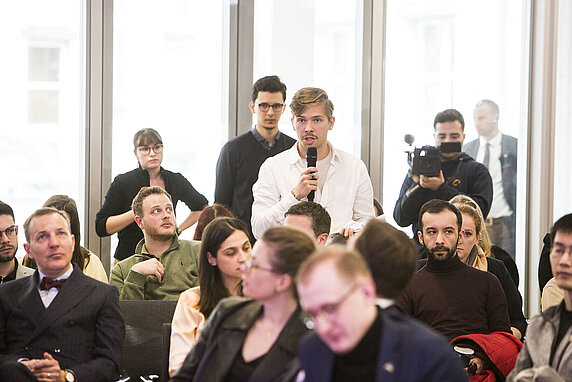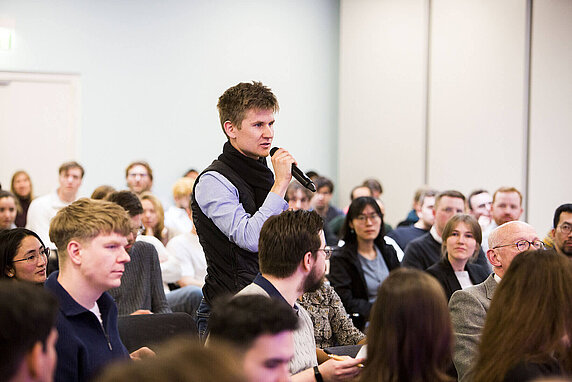Swedish Foreign Minister Tobias Billström addressed NATO, Ukraine and Swedish security policy in keynote speech to the Hertie School community.
On 21 March 2024, the Hertie School and the Centre for International Security were honoured to host Tobias Billström, Sweden’s Minister for Foreign Affairs, in collaboration with the Swedish Embassy in Berlin. In an event introduced and moderated by Hertie School President Cornelia Woll, Tobias Billström delivered a keynote speech about the Swedish perspective on Europe’s changing security landscape, followed by a discussion with the audience.
Understand today, shape tomorrow “a very fitting slogan for the diplomacy of our time”
Billström began by highlighting the relevance of the Hertie School’s motto “Understand today. Shape tomorrow.”, arguing that a high level of ambition will be needed for “shapers” to navigate the upheaval of Europe’s besieged security order. With the post-Cold War era at an end, Sweden has undergone its own “Zeitenwende”, joining NATO after two centuries of non-alignment. Sweden’s NATO membership can be seen as a paradigm shift in its approach to foreign policy, Billström said, but it can also be taken as the “final step in the decades of ever-closer partnership with the Alliance”.
Billström emphasised Sweden’s close relationship with Germany and praised Germany’s support for Sweden’s NATO bid. Germany was one of the first to ratify Swedish NATO membership, and offered Sweden bilateral security guarantees during the sensitive window between application and accession. Germany and Sweden share a commitment “to the rule of law, to democracy, to human rights”, and now to European defence, Billström stressed.
“Unity, solidarity and cohesion will be the guiding lights for Sweden as a NATO member”
Billström also gave an overview of Sweden’s priorities as the newest member of NATO. As Russia works to sow discord within NATO, safeguarding unity is essential, he argued. To counter the threat from Russia, European countries must also seriously increase defence spending – to that end, Sweden has already raised spending over the 2% of GDP requested by NATO. Another strong commitment Sweden will be making as a NATO member is to enhance cooperation between NATO and the EU.
Above all, protecting and supporting Ukraine in its struggle against Russia’s aggression “is and will remain the top priority for Sweden’s foreign policy”. The war will have lasting consequences for Russia, Ukraine and Europe, and “peace at any cost would only invite further aggression”. Billström reminded the audience that Russia could also stop the war at any time by withdrawing, and said that Europe must supply Ukraine with all of the financial, military and political support it needs, with a dual focus on urgency and endurance.
Lastly, Billström touched on how Sweden can strengthen NATO’s deterrence and defence in the Nordic and Baltic regions. With all Baltic countries except Russia now part of NATO, new opportunities for foreign policy cooperation and deeper security dialogues have emerged and are being pursued by Sweden. Once again, Billström highlighted the importance of Germany as a partner in the region.
“Going back to those dark days" of empires and domination is “exactly opposite” Sweden’s worldview
In discussion with the audience, Billström commented on Sweden’s foreign policy position on a variety of issues, from the delivery of humanitarian aid to Gaza to Sweden’s relationships with Turkey and Hungary to the risks posed by China and the upcoming US election. In a striking statement on the long-term risks posed by Russia, Billström used the example of Baltic coats of arms in the backdrop of Russian President Vladimir Putin’s public appearances to illustrate that Russia’s long-term aim remains recreating its empire.
After the public event, Billström stayed at the Hertie School to continue his official visit, with German Foreign Minister Annalena Baerbock coming to the school for their bilateral meeting.
To watch the full keynote address and audience discussion, see the video below.

